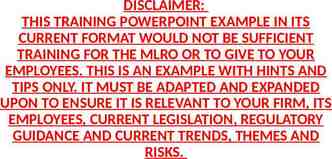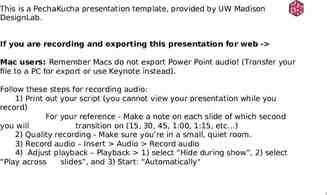OBHR 202 PERFORMANCE MANAGEMENT AND COMPENSATION WEEK 2 Job
17 Slides209.22 KB
OBHR 202 PERFORMANCE MANAGEMENT AND COMPENSATION WEEK 2 Job Roles Reference: Remuneration Handbook Chapter 2
O V E RV I E W The objectives of this session: Understand how job roles are the “foundation” of remuneration Be familiar with the terminology for job descriptions Examine the factors influencing jobs Learn how to write a job description Check and obtain a commitment to a job description
DIFFERENCE BETWEEN A JOB DESCRIPTION & ROLE DESCRIPTION JOB DESCRIPTION Depicts an accurate, realistic, current picture of what tasks make up a job Comprises information such as job’s location, purpose, responsibilities, authority levels and supervisory relationships ROLE DESCRIPTION Explains the part to be played by individuals in fulfilling their job requirements Often incorporates the results of skills or competence analysis and sometimes performance standards
TERMS USED IN THE PROCESS OF WRITING JOB DESCRIPTIONS Task Elements Tasks Duties Responsibilities Position Job Occupation Work Team Job Analysis Job Description Role Description Competence
TERM DEFINITION EXAMPLE: Executive Summary Task elements These are the smallest work elements Insert a piece of paper into a printer Task Task elements combine to form a task with a defined outcome Type the minutes of a particular meeting Duties Specific requirements of the job Need to maintain a record of minutes from a series of meetings Responsibiliti es What the employee is held accountable for Accountable for the recording, typing, and maintenance of the record Position Where there are enough duties and responsibilities to require the employment of a worker, a position exists Job Where more than one worker is employed in the same or similar position(s), a job exists Occupation Jobs common to many separate organisations Many organisations employ secretaries, therefore it is an occupation Work team A work group or team exists when a worker interacts with others to produce a component of a product or service for sale or consumption The sales team headed by the sales manager of which the executive secretary is a member Job analysis The process of determining and defining the content of jobs Job analysis of the executive secretary job Job description The description of a job as a result of job analysis Executive secretary job description Role description A broader look at the job description Provision of administrative support Competence The skills, attitude and behaviour required Proficient provision of administrative support Executive secretary to the MD versus the executive secretary job. When two workers are employed as secretaries and their duties and responsibilities are the same, there are two secretarial positions but only one secretarial job
PURPOSES OF JOB DESCRIPTION WRITING PROCESS Motivations for carrying out a job description writing process are to enable: Job evaluation – the information on which the job will be graded Creation of the information needed for organisational review Detailed information for recruitment Development of job procedures and performance standards Development of a framework for performance and progress reviews Detailed information for the development of skills, training programmes, career pathing, and manpower planning Development of specific plans for individual induction training To assist with an assessment of how competent the incumbents are in relation to the requirements of the job
FA C T O R S I N F LU E N C I N G J O B S Non-discretionary for the Individual Variable & discretionary for the individual Organisation: structure & Skills policy Experience Legal requirements Personality Division of labour Performance Design of equipment Physical arrangement Methods, procedures, traditional practices Job standards Work environment
JOB DESCRIPTION WRITING PROCESS Often conducted by Certain skills are required for writing job descriptions Supervisor Job incumbents HR specialists External consultants Combination of the above Prior to sign off, the accuracy of descriptions should be agreed on. Good interpersonal skills Good writing skills Knowledge of how the organisation functions Inquisitive and analytical nature Objectivity in business dealings
P L A N N I N G A N D P R E PA R AT I O N F O R JOB DESCRIPTION WRITING Writing phase should be carefully planned. Key questions to answer: 1. How many job descriptions should be written? 2. How many job analysts are needed to complete the task in time to allow for the grading committee to be trained, all jobs to be graded, and the pay review (if there is one) to be completed? In addition, the following requirements should be discussed: Selection of employees to be interviewed Competence of employees to be interviewed Interviews to be conducted as “ one-on-one”, with a small group of employees in the same job or with the employee and a shop steward (if appropriate) Provision of an interview room An opportunity to observe the incumbent in operation (if necessary) Gathering previous job descriptions and other information to facilitate the analyst
P L A N N I N G A N D P R E PA R AT I O N F O R JOB DESCRIPTION WRITING It is often more expedient to interview the managers regarding the jobs in their department and writing job descriptions from this interview. Follow these tips to ensure effective planning of the job description writing process: Asking for an organogram of the division or department in advance helps with understanding the big picture; it makes it easier to get a feel for when incumbents inadvertently include the duties of their manager in their own job descriptions. The programme should progress from lower-level jobs upwards – enabling analysts to work on easier jobs first, gaining confidence for the writing of more complex descriptions and allows a clearer view of the organisation’s operations and hierarchy. Details of the interview are to be properly recorded. If it is not possible to interview all employees, make it clear that representatives of certain job categories were chosen. Monitor the quality and checking process for each job description. All completed descriptions should be signed off by the employees, supervisor, shop steward where appropriate, and head of department. Discuss reproduction of job descriptions for the grading committee. Each member of the grading committee requires a copy of the job description when doing the grading.
WRITING UP JOB DESCRIPTION I. Build job description immediately after the interview II. List tasks in chronological sequence for lower-level jobs (or, in order of importance for higher-level jobs) III. Follow a concise and uniform style, such as: Use point form Start every sentence with action verbs Use an agreed format for organisational design Talk in the present tense IV.Use level cutters to clearly demarcate the difference between two adjacent job levels for job evaluation purposes
C H E C K I N G A N D O B TA I N I N G COMMITMENT TO A JOB DESCRIPTION 1 Interview incumbent 2 Check details with supervisor 3 Ensure agreement between incumbent and supervisor 4 Draft job description 5 Check the draft job 6 Check description with incumbent, supervisor, shop steward and head of department 7 Get the job description typed up 8 Having the job description signed by the incumbent, supervisor, shop steward, and head of department
SAMPLE JOB DESCRIPTION Compensation Analyst Salary Grade/Level/Family/Range: [Insert applicable information.] Reports to Compensation, benefits and HRIS manager Date: [Indicate date for job description creation or review.] JOB DESCRIPTION Summary/Objective The compensation analyst is the key resource for the company's North American salary and incentive programs and supports other compensation programs such as international, sales and stock options. Essential Functions Collaborates with the compensation manager/consultants on a variety of projects, including program design, analysis, budgeting, implementation of new programs and stock reload. Administers North American base pay and bonus programs, including annual focal review and bonus cycles. Manages projects such as survey participation and analysis and compensation integration for mergers and acquisitions. Develops and documents procedures to streamline processes and ensure compliance with regulatory requirements. Coordinates with HR managers to educate managers. Works with HRIS and IT staff to ensure that the [HRIS software] system meets compensation needs and is updated to reflect changes to salary structures, bonus programs, etc. Communicates salary and bonus programs in new-hire orientation. Assists HR managers and other managers with compensation-related issues. https://www.shrm.org/resourcesandtools/tools-and-samples/job-descriptions/pages/cms 001180.aspx
SAMPLE JOB DESCRIPTION Compensation Analyst Competencies Business Acumen Communication Consultation Critical Evaluation Ethical Practice Supervisory Responsibility This position has no supervisory responsibilities. Work Environment This job operates in a clerical office setting. This role routinely uses standard office equipment such as laptop computers, phones, photocopiers and filing cabinets. This is largely an office role; however, some filing is required. This would require the ability to lift files, open filing cabinets and bend or stand on a stool as necessary. Travel Occasional travel to corporate sites in conjunction with new program rollouts is expected. https://www.shrm.org/resourcesandtools/tools-and-samples/job-descriptions/pages/cms 001180.aspx
SAMPLE JOB DESCRIPTION Compensation Analyst Required Education and Experience Three to five years of experience in the analysis, design and/or administration of compensation programs. Bachelor's degree. Other Duties Please note this job description is not designed to cover or contain a comprehensive listing of activities, duties or responsibilities that are required of the employee for this job. Duties, responsibilities and activities may change at any time with or without notice. Signatures This job description has been approved by all levels of management: Manager HR Employee signature below constitutes employee's understanding of the requirements, essential functions and duties of the position. Employee Date https://www.shrm.org/resourcesandtools/tools-and-samples/job-descriptions/pages/cms 001180.aspx
S U M M A RY In this session, we have learnt that: Job descriptions are the foundation of remuneration Job description is not role description Jobs are influenced by a two types of factors Interviews are required prior to the development of job descriptions
Exercise: IMPROVE JOB DESCRIPTION 1. How many of the elements described in this session can you find in this description? 2. What is missing? 3. How would you improve upon it? Example: Accounting Supervisor Job Responsibilities Secures financial operations by monitoring and approving financial processing, reporting, and auditing; supervising staff. Job Duties Accomplishes accounting human resource objectives by selecting, orienting, training, assigning, scheduling, coaching, counselling, and disciplining employees; communicating job expectations; planning, monitoring, appraising job contributions; recommending compensation actions; adhering to policies and procedures. Meets accounting operational standards by contributing financial information to strategic plans and reviews; implementing production, productivity, quality, and customer-service standards; resolving problems; identifying system improvements. Meets accounting financial standards by providing accounting department annual budget information; monitoring expenditures; identifying variances; implementing corrective actions. Maintains cash flow by monitoring bank balances and cash requirements; investing excess funds. Approves cash disbursements by verifying check amounts against invoices, authorizing checks and wire transfers. and Qualifications Skills Approves ledger entries by auditing transactions Accounting, Supervision, Benefits Administration, Audit, Managing Processes, Reporting Research Results, Quality Management, Corporate Finance, Developing Budgets, Attention to Detail, General Math Skills






















